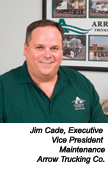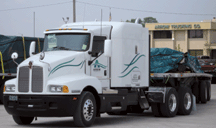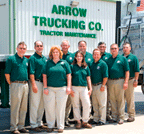As a veteran fleet manager, Jim Cade knows that effective equipment decisions are essential to the ongoing success of any trucking operation.
As the executive vice president, maintenance at Arrow Trucking Co., he is using his experience – combined with the efforts of a highly skilled management team – to ensure that the right vehicles are in service for the carrier and its customers.

Based in Tulsa, Okla.., Arrow is a for-hire flatbed carrier operating in the 48 lower states, Mexico and Canada. The company mainly provides over-the-road service but also has regional fleets domiciled in Dallas, Houston and Laredo, Texas; Fontana, Calif.; and Masury, Ohio. It also operates a heavy-haul division providing over width, over height and heavy lift services. The Arrow fleet currently consists of more than 1,400 tractors and 2,500 trailers.
“One of our objectives,” Cade says, “is to be able to scale a 50,000-lb. payload, which means we have to keep the combined empty weight of the tractor and trailer below 30,000 lbs. For that reason we are always looking for weight saving ideas. In recent years, for example, we’ve moved to combination aluminum deck and steel frame trailers to reduce weight but maintain the strength and longevity we expect. We also began spec’ing aluminum wheels on tractors, especially as new engines and other required items have stretched our ability to stay under 30,000 lbs.”
Until recently, Arrow operated a standardized fleet.
“Due to economic concerns and other factors, we decided to try other vehicle and engine suppliers,” he says. “This has allowed us to compare the pros and cons of each configuration and will help us make more informed choices about the type of vehicles and components we want to operate in the future. It also has allowed us to experience the various levels of service and support that we receive from different suppliers.
“Another benefit of getting away from a standardized fleet is that it gives our drivers options,” Cade says. “Some like one model of truck over another and giving them a choice helps attract and retain drivers for the fleet. Our trade cycles are determined by lifecycle costs, but there’s a strong dose of driver retention thrown in as well. In our operation, to help attract and retain the best drivers, we trade every four to five years and currently the average fleet age is under one and one-half years.”
Strong relationships
While the word “partnership” is overused, Cade says, it’s critical for Arrow to have strong relationships with its suppliers.
“A supplier that supports you after the sale is very important and can have a big impact on your business,” he says. “For example, late last year we were fortunate to have an unexpected surge in business that caused a shortage of trailers in our fleet. The lead-time for new trailers was long and used trailers matching our specs were not available. Our trailer supplier not only placed an expedited order for new trailers, but also was able to find trailers for us to partially fill the gap. That’s the kind of supplier you want to do business with in the future.”
The Arrow fleet does not lend itself well to testing and evaluating components, he says.
“We’re mainly a long haul operation so we don’t see our trucks or trailers on as regular a basis as some other fleets,” Cade says. “That doesn’t mean we don’t test or evaluate components, but we make sure that suppliers are clear about this aspect of our operation when they ask us to evaluate items. We’re also not a fan of testing just to be testing something. To even consider implementing an evaluation, the potential benefits for Arrow have to be clearly defined.”

The most important benefit of any vehicle, system or component for Cade is reliability.
“You can buy a cheap product but if it’s in the shop all the time it’s not doing the company or the driver any good,” he says. “Over the past couple of years, we’ve begun measuring unscheduled shop visits as an indicator of reliability in our operations, and we see big differences between the makes of vehicles we operate.”
Ensuring reliability is central to the maintenance philosophy at Arrow.
“Drivers represent the first level of our maintenance program,” Cade says. “Every week, I have the opportunity to address new drivers coming into the company during their orientation program. The first thing I tell them is that they are the maintenance organization’s primary customers and our job is to take care of them and the trucks they drive. The second point is that they are the first line of defense in our maintenance program. As operators of the vehicles they play a major role in our maintenance programs and without their help our program will fail.”
Arrow’s maintenance program begins with a safety inspection, which is scheduled every 30 days for power units. The program is based on the Commercial Vehicle Safety Alliance (CVSA) roadside inspection criteria and includes a chassis lubrication. The primary preventive maintenance interval for tractors is no later than every 30,000 miles but can be as early as every 25,000 miles, and trailers get a full PM every 90 days.
“These windows gives us the ability to perform PM when the equipment is available and not bring it back at a later date just for service,” Cade says. “It also helps us stay current on our PMs by giving the shops flexibility.
Meeting the challenge
“One downside to not standardizing has been that it makes it harder on our shops to repair and support the various trucks in our fleet,” Cade says. “Some of our technicians have commented that they like the variation that the different trucks provide, but we’ve had to meet this challenge by increasing the amount of our training we provide. To keep our technicians current we schedule in-house training and rely heavily on our suppliers to provide programs. We also use some outside training resources, but based on our short trade cycle most of our training needs are of the type that can be handled in-house.”
Acquiring and keeping good technicians is becoming almost as challenging as finding and keeping good drivers.
“Like many trucking companies we are aligned with trade schools in our area to recruit technicians,” he says. “This has been a good arrangement for us and for the schools.
“In addition to working with trade schools, we also believe you have to approach technician recruiting from three different angles,” Cade says. “First, we want to find highly qualified technicians who can walk in off the street and begin contributing to our organization right away. You have to seek out these individuals and when you find them do everything you can to attract them to your team.
“Since these kind of technicians are not that plentiful you have to look in other places as well,” Cade adds. “There are people in related industries, for example, who have a broad range of experience and with a little effort, training and support can become contributors to your organization. The challenge is to find those who are willing to make a change.
“Finally, there are people who have the desire and a good work ethic, and there is a place for these types of people as well,” he says. “Over the last two years we’ve hired a couple of people like this, provided loaner tools, training and support, and today they are major contributors in our shops.”
Information quality
To help manage all of its maintenance activities, 1.5 years ago Arrow began utilizing the Transman computerized management information system from TMT Software.
“The software has improved the quality of information we are collecting and reduced the amount of paperwork in our shops,” Cade says. “It provides electronic repair orders for our technicians to access directly at terminals we have set up in strategic locations on the shop floor and utilizes touch-screen technology to simplify data entry.”
Cade notes that the Transman system informs technicians when a repair is covered by warranty so enough detail can be gathered to make sure parts are properly identified. The warranty section of the system is then used to prepare claims in a standard format.

“With the software, shop supervisors can monitor technician activity and check repair order histories,” he says. “It also provides management reports on numerous aspects of maintenance and purchasing, which allows us to identify developing issues almost in real time. Furthermore, its module for our Road Repair group helps track issues, record comments and monitor the repair process all through the event. Through tracking and constant follow-up we have reduced vehicle downtime with this system.”
Not to be overlooked, according to Cade, is the Transman system’s parts purchasing and management program.
“Transman has given us the opportunity to re-evaluate the way we manage parts,” he says. “It’s helped us reduce parts inventory while improving the number of inventory turns. Obsolete parts have dropped to almost nothing and we can now more easily identify parts that need to be stocked based on usage. The parts system has also helped us combine our parts purchasing volume with certain vendors and better leverage our purchasing power locally and nationally.”
While limiting outsourcing means better control over costs, according to Cade, the long haul nature of Arrow’s business means it’s not always feasible or economically sound to bring vehicles back to a company shop for repairs. In those cases, they outsource work to approved and reputable vendors.
One program that has worked very well for Arrow is the agreement it entered into two years ago with Bridgestone Firestone and Bandag for tire and retread purchases and related services, according to Cade.
“Working with these two companies we established a just-in-time tire delivery program, which virtually eliminated inventories in our terminals and greatly reduced it in our main facility,” Cade says. “Tires represented an opportunity for major improvement at Arrow, but we also knew that a good tire management program goes beyond selecting a brand.”
Continuous improvement
From Cade’s point of view, there are key factors in driving costs out of a tire budget while simultaneously improving uptime. Air pressure maintenance and alignment programs head that list.
“Bandag performs bi-annual fleet inspections and the market team provides us with reports that help benchmark how we are doing in the areas of air pressure maintenance and matching tires,” Cade says. “We have seen continuous improvement with each new report.”
One rather unusual customer service aspect of the Arrow operation is the spotting of trailers in shipper’s yards so customers can load them at the most convenient time.
“This practice is unique for a flatbed hauler,” Cade says, “and it poses a challenge for maintaining trailer tire air pressures. To offset potential problems, we have begun spec’ing the Meritor Tire Inflation System by PSI. The automatic tire inflation systems on trailers have played a role in the drastic reduction we have seen in enroute failures.
“The management of casings is very critical to reducing tire costs,” Cade says. “For example, we were able to reduce enroute tire replacements by more than 60 percent by effectively managing our casing assets and getting every penny out of our tire investments. Despite the fact that our fleet continues to grow and log more miles annually, we were able to reduce by 25 percent the number of retreads purchased this past year.
“We know that a smart long-term investment rather than a low initial purchase price helps us realize cost savings, and this includes the choices we make for tires and retreads,” Cade says.
“Some of the credit for the savings in tire costs also comes from the better performance we are getting from our original Bridgestone R280 and M726 radials, and by using Bandag’s FCR drive and FCR trailer retread designs.”
Industry associations
Along with working internally and with suppliers to ensure the ongoing efficiency of Arrow’s equipment and maintenance programs, Cade readily participates in several industry associations. Among them are the Technology & Maintenance Council, the Society of Automotive Engineers, the Oklahoma Trucking Association Maintenance Council and the Commercial Vehicle Safety Alliance.
“While belonging to these associations is essential in today’s environment, participating is also a requirement,” Cade says. “There are so many issues affecting the industry that you need a way to separate facts from myths. Active participation in these associations not only allows you to learn directly from the source about what is happening and why, it also allows you to provide feedback on its direction.”
In all things related to equipment and maintenance at Arrow Trucking Co., the direction Jim Cade is heading is aimed at making the right decisions and ensuring that every aspect of every program enhances the company’s success and its reputation as an on-time, customer-focused carrier.
